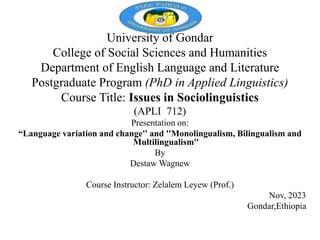The presentation examines language variation and change, focusing on sociolinguistic methods and principles, including dialectology and the social factors influencing language use. It highlights the interconnectedness of language variation and change through factors like geography, social stratification, and bilingualism, and explains how language evolves over time. The study emphasizes the importance of analyzing linguistic variation within social contexts to understand the relationships between language, identity, and society.






![The Concept of Language Variation and
Change
Language variation: the diversity of language use
within and across speech communities.
Influenced by many factors, such as geography,
ethnicity, age, gender, education, occupation, and
style.
For example, speakers of English may use different
accents, words, grammar, and expressions
depending on where they live, who they interact
with, and what situation they are in.
The variable : an abstract representation of the
source of variation, realised by two or more variants,
e.g ‘think’ // :[],[f].](https://image.slidesharecdn.com/languagevariationandchangepresentation1-231217092808-9dd67769/85/language-variation-and-change-Presentation1-pptx-7-320.jpg)





























